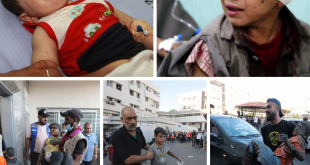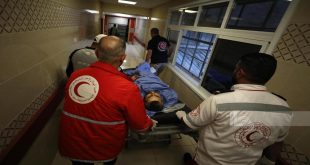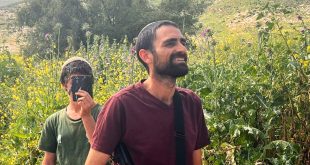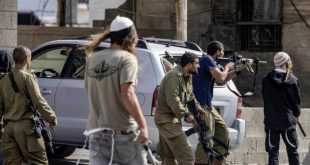The decision reflects lack of respect for the lives of Palestinians and conveys a dangerous message to soldiers and commanders
The MAG Corps posted a notice on its Hebrew website stating that the investigation into the killing of Lubna al-Hanash by military gunfire has been closed without filing charges. According to the notice, the case was closed because the soldier who fired the shots that killed al-Hanash and injured a relative who was with her, was firing at a person who had lobbed a Molotov cocktail at Israeli cars. The notice stated that the investigation “indicated that the soldier who fired did not notice the deceased at the time of shooting”, despite the fact that al-Hanash had been standing close to the escape route of the person targeted. The MAG Corps claimed that as the open-fire regulations permit “opening fire toward terrorists immediately after an attack, including an attack using Molotov cocktails”, the shooting did not breach regulations and did not constitute a criminal offense. It added, however, that a lieutenant colonel who was with the soldier at the time will receive a disciplinary reprimand for failing to convey the open-fire regulations to soldiers under his command, and that no direct causal link was found between the said failing and the killing of al-Hanash.
The details of the incident as provided by the MAG Corps differ substantially from the facts uncovered by B’Tselem’s investigation. Yet even in accordance with MAG Corps’ reasoning, the soldier who fired the shots – whose life was not in danger at the time – was obligated to ensure that no bystander be harmed. It is unreasonable that the MAG Corps permit use of a lethal weapon without minimal precautions. Therefore, the explanation given that the soldier did not notice al-Hanash at the time of the shooting cannot in any way justify the decision to close the case. First, B’Tselem’s examination of the scene found that no physical obstacle in the terrain could have blocked the soldier’s view of the spot where al-Hanash and her relative, Sou’ad, were standing; the latter even told B’Tselem that she saw the soldier who fired the shots, from the spot where she had been hit. Second, even if the soldier had shot without noticing the two women, this serves to indicate that he did not examine the area carefully before shooting, or that he fired even though he did not have a clear line of vision.
The decision to close the case without charges demonstrates yet again how Israel’s military law enforcement authorities systematically refrain from enforcing the law on soldiers involved in harm to Palestinians. This policy promotes lack of respect for the lives and safety of Palestinians and encourages a trigger-happy approach. B’Tselem has written to the Military Police Investigation Unit (MPIU) demanding a copy of the investigation file, in order to appeal the decision.
The incident:
Lubna al-Hanash of Bethlehem was just shy of her 22nd birthday. On 23 January 2013, she went to visit a relative, Sou’ad al-Hanash, 38, a resident of al-‘Arrub RC. The two women went for a stroll along the garden paths in the nearby College of Technology, which serves as a recreation area for al-‘Arrub residents. At approximately 2:30 P.M., they were walking towards an entrance gate to the college, located on Route 60, from where Lubna was supposed to travel back home. When they were about 100 meters away from the gate, shots were suddenly fired at them. At this point, Sou’ad perceived the soldier who shooting at them. He was standing by the road, on the other side of the closed gate. Lubna sustained a gunshot wound to her head and Sou’ad to a hand. The two women were taken separately to Al-Ahli Hospital in Hebron, where Lubna died of her wounds about an hour later.
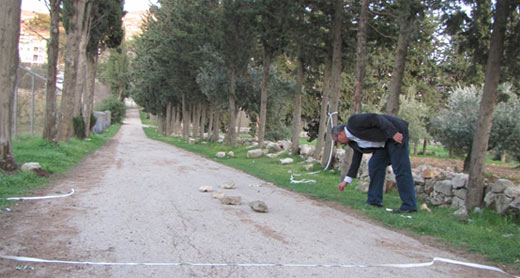
B’Tselem field researcher Iyad Hadad examines the scene of the incident. Photo by Musa Abu Hashhash, B’Tselem, 23 Jan. 2013
That same day, Sou’ad al-Hanash related the events to B’Tselem field researcher Musa Abu Hashhash:
We walked around the campus – which was empty, with no students or teachers around, for about an hour and a half. At around 2:30 P.M., I was walking with Lubna towards the side entrance that leads to Route 60. She wanted to wait there for a ride back to Bethlehem. We were walking down the pine tree path when suddenly, I heard several shots. Right away, I noticed a soldier in uniform standing on the other side of the closed gate, about 100 meters away from us. Behind him was a parked white car, facing in the direction of Hebron. As soon as I turned around to run away, I felt something hit my left hand. I realized I’d been hit by the gunfire and I started running, leaving Lubna behind. I thought she was running just behind me. I ran about 50 meters, until I saw two people from the college staff. One of them bandaged my hand and the other went to find Lubna.
I was taken in a private car to a nearby medial clinic, and from there by ambulance to a hospital in Hebron. My family, who came to the hospital, kept Lubna’s condition from me. My brother only told me that she’d been hit and was in the same hospital as me, in okay condition. I had surgery on my hand, because the bullet went through it and injured the tendons of one finger. Just before I went into surgery, I heard from other patients there that Lubna had died. I started screaming and was sure I’d faint. I couldn’t believe it. She had been so happy walking through the campus. I was happy too, that she was seeing the place – her first and last visit there.
In an article that Israeli daily Ha’aretz ran on the day of the incident, the IDF Spokesperson was quoted stating that a soldiers who were “driving along the road were attacked with stones and Molotov cocktails, and the soldiers, who felt they were in danger, opened fire at the source of the stone-throwing.” Later that day, it was reported that an officer in Central Command said that a bag containing several Molotov cocktails had been found in the area, but the IDF Spokesperson would not say whether the women had been the target of the gunfire. Media reports further indicate that the soldiers involved in the incident were Lieut. Col. Shahar Safda, Second-in-command of the Yehuda Brigade, and another soldier. They were driving along Route 60 in a civilian car when they noticed stones and Molotov cocktails being thrown, at which point they decided to stop and get out of the car. They then opened fire and tried to pursue the stone-throwers.
B’Tselem’s inquiries have been unable to confirm or refute the claim that stones and Molotov cocktails had been thrown in the vicinity prior to the shooting. They did find, however, that Lubna and Sou’ad al-Hanash had nothing to do with the alleged assault and – as can be gleaned from Sou’ad’s testimony – were unaware of it. Therefore, there was no justification for firing at the women. The military’s response makes no mention of the fact that the two passersby were hit by the gunfire, nor that firing live ammunition at the upper torso is permitted only when the targeted individual poses immediate mortal danger to soldiers or civilians, which was clearly not the case in this instance.

 العربية
العربية עברית
עברית Türkiye
Türkiye Русский
Русский Français
Français We Watch Israeli Violations Specialized website in monitoring and documenting Israeli violations against Palestinians
We Watch Israeli Violations Specialized website in monitoring and documenting Israeli violations against Palestinians



